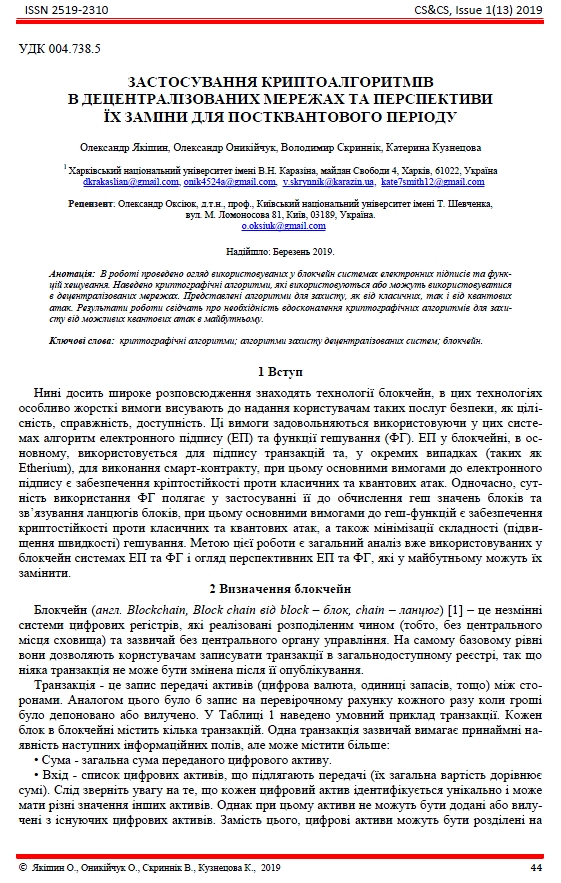Application of cryptographic algorithms in decentralized networks and prospects for their replacement for the post-quantum period
Abstract
The article reviewed cryptographic algorithms that are used or can be used in decentralized networks. Algorithms for protection, both from classical and from quantum attacks are given. In the work there is a general analysis of the methods already used. Reviewed algorithms for protection, both from classical and from quantum attacks are given. The results of this work show the need for cryptographic algorithms to protect against possible quantum attacks in the future.
Downloads
References
NISTIR 8202 Blockchain Technology Overview / Yaga D., Mell P., Roby N., Scarfone K. Р. 50-59. URL:https://csrc.nist.gov/publications/detail/nistir/8202/final
Mearian L. IBM Touts Quantum Computing Advance. URL: https://www.computerworld.com/article/2502275/ibm-touts-quantum-computing-advance.html
Zalka Chr. Grover’s quantum searching algorithm is optimal. Phys.Rev.1999. A60. Р. 2746 – 2751
Shor P. Algorithms for Quantum Computation: Discrete Logarithms and Factoring. Foundations of Computer Science. Proceedings 35th Annual Symposium on - IEEE. 1994. P. 124 – 134.
SHA-2. URL: https://ru.wikipedia.org/wiki/SHA-2
Почему Keccak настолько крут и почему его выбрали в качестве нового SHA-3. URL: https://habr.com/ru/post/168707/
Comparison of cryptographic hash functions. URL: https://en.m.wikipedia.org/wiki/Comparison_of_cryptographic_hash_func-tions?wprov=sfti1
NISTIR 7896. Third-Round Report of the SHA-3 Cryptographic Hash Algorithm Competition. NIST. 2012. Р. 50 – 65.
Digital Signature in Blockchain. URL: https://dzone.com/articles/digital-signature-2
Johnson D., Menezes A., Vanstone S. The Elliptic Curve Digital Signature Algorithm (ECDSA). International Journal of Information Security. 2001. Vol. 1, Issue 1. Р. 36 – 63.
Haddaji R., Ouni R., Bouaziz S., Mtibaa A. Comparison of Digital Signature Algorithm and Authentication Schemes for H.264 Compressed Video (IJACSA). International Journal of Advanced Computer Science and Applications. 2016. Vol. 7, № 9. Р.7.
Post-Quantum Cryptography. URL: https://csrc.nist.gov/Projects/Post-Quantum-Cryptography/Round-1-Submissions
CRYSTALS-Dilithium Algorithm Specifications and Supporting Documentation / Ducas L. and all. URL: https://pq-crystals.org/dilithium/data/dilithium-specification.pdf
SPHINCS: practical stateless hash-based signatures / Bernstein D.J. and all. URL: https://www.iacr.org/archive /eurocrypt2015/90560214/90560214.pdf
Merkle R. A certified digital signature. Advances in Cryptology - CRYPTO’ 89 : Proceedings /Gilles Brassard, ed. Vol. 435 of Lecture Notes in Computer Science. Berlin: Springer / Heidelberg, 1990. Р. 218–238.
Merkle signatures with virtually unlimited signature capacity / Buchmann J. and all. Applied Cryptography and Network Security/ Katz J. and Yung M. ed.Vol. 4521 of Lecture Notes in Computer Science. Berlin: Springer / Heidelberg, 2007. Р. 31–45.
Rogaway P., Shrimpton T. Cryptographic hash-function basics: Definitions, implications, and separations for preimage resistance, second-preimage resistance, and collision resistance. FSE / Roy B.K., Meier W., ed. Vol. 3017 of Lecture Notes in Computer Science. Berlin: Springer / Heidelberg, 2004. Р. 371–388.
Buchmann J., Dahmen E., Hülsing A. XMSS - A Practical Forward Secure Signature Scheme Based on Minimal Security As-sumptions. Post-Quantum Cryptography. PQ Crypto 2011. Vol. 7071 of Lecture Notes in Computer Science. Berlin: Springer / Heidelberg, 2011. Р. 117–129.


